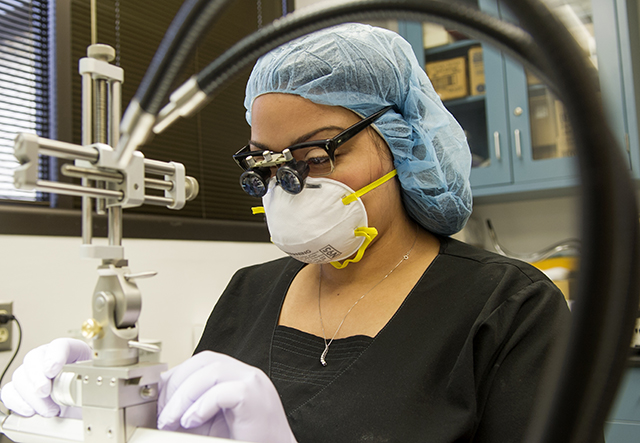Getting to the root of pain

This recent graduate’s postdoctoral plans keep her anchored at Texas A&M University Baylor College of Dentistry, where she’ll further the dental school’s research on estrogen and TMJ disorders.
Dr. Crystal Stinson received her dental degree and certificate in education for health care professionals just weeks ago. Now she is delving into research involving temporomandibular joint pain — the subject of her dissertation — and an issue she knows about firsthand.
“It definitely was a motivating factor,” says Stinson of the role her own TMJ disorder played in the decision to focus on the topic. “This is a road I may have to cross in the future,” she says of the possibility of undergoing developing therapies.
As part of a $174,000 diversity supplement awarded to Stinson over the next two years from the National Institutes of Health – National Institute of Dental and Craniofacial Research, she will finish her doctorate degree with four years of research under the umbrella of a $1.5 million NIH R01 grant awarded in 2012 to Dr. Phillip Kramer, professor in biomedical sciences. A portion of Stinson’s NIH-approved research stipend will hinge on her ability to maintain her dentistry hand skills, a trend she says is intended to smooth the transition from bench-top study to chair-side care.
With potential clinical applications still years away, Kramer’s current research, “Estrogen and TMJ Pain,” uses animal models to explore the effect of estrogen on myofascial pain, which occurs in the masseter muscle used for chewing. Stinson’s portion will home in on how estrogen levels influence pathways and circuits in the brain that control pain in the mouth, jaws and face.
Her contribution will build upon more than a decade of research at the college, all with a common objective: finding new ways to alleviate pain in the more than 10 million Americans estimated to suffer from TMJ disorders.
“The goal of this research is to discover potential targets in which turning up or down activity — for example, turning on specific neurons — would reduce chronic pain in individuals with disease,” Kramer says.
—Jenny Fuentes